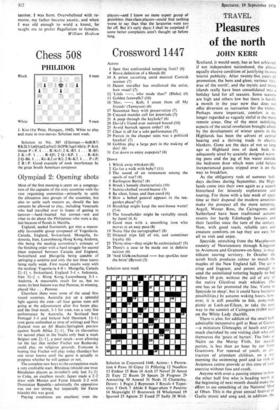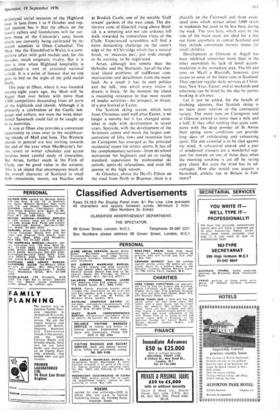TRAVEL
Pleasures of the north
JOHN KERR
Scotland, it would seem, has at last achieved, if not independent nationhood, the almost equally elusive condition of justifying its own
tourist publicity. After twenty-five years of promotion, the bens and glens, various `rivi-
eras of the north', and the mystic and misty islands really have been consolidated into a holiday land for all seasons. Some seasons are high and others low but there is hardly
month in the year now that does not offer diversion or recreation for the visitor. Perhaps more important, comfort is no longer regarded as vaguely sinful in the more remote areas. One of the most satisfying aspects of the social revolution brought about by the development of winter sports in the Highlands has been the advent of central heating and a thriving trade in electric blankets. Gone are the days of not so long ago at Highland inns of dank beds in- adequately aired by quaintly designed warm- ing pans and the jug of hot water outside the bedroom door which went cold before inexperienced guests tripped over it on the way to breakfast.
As the obligatory rush of summer holi- days declines during September, the High- lands come into their own again as a superb hinterland for leisurely exploration and touring. For those with a late week of spare time at their disposal the modern amenities make the prospect all the more tempting. Argyll, Wester Ross, the Cairngorms and Sutherland have been traditional autumn resorts for hardy Edinburgh lawyers and their families since the turn of the century. Now, with good roads, reliable cars and creature comforts on tap they are easy for all to visit and enjoy.
Speyside, stretching from the Macpherson country of Newtonmore through Kingussie to Aviemore and Grantown-on-Spey, is mag- nificent touring territory. In October the scrub birch produces colour to match the maples of the New England fall. The air is crisp and fragrant, and potent enough to send the uninitiated tottering happily to bed before 10 p.m. without the aid of any of the native Glenlivet malt whiskies. (No one has so far promoted the line, 'Come to Speyside to sleep', but it could have lucrative possibilities.) In autumn waking hours, how- ever, it is still possible to fish, pony-trek. picnic at Loch-an-Eilean, or take the easy way to the summit of Cairngorm (4,084 feet) on the White Lady chairlift.
There is also, for addicts of the small ball. admirable inexpensive golf at Boat of Garten —a miniature Gleneagles of heath and pine much cherished by one visiting club who call themseves the 'goats of barten'. The links at Nairn on the. Moray Firth, for seaside purists, is less than an hour by car from Grantown. For renewal of youth, or dis- traction of attendant children, on a wet morning the swimming pool and ice rink at Aviemore centre provide at this time of year exercise without fuss and crush.
Anyone with even a passing interest in how the other half live who is heading north at the beginning of next month should make the effort to.see something of the National Mod at Oban. This is the great annual festival of Gaelic music and song and, in addition, the
archetypal social occasion of the Highland year. It lasts from I to 9 October and top- ical opinion has it that the effects on the town's rafters and foundations will far sur- pass those of the Concorde's sonic boom which are currently being calibrated by re- search scientists in Oban Cathedral. The Mod. like the Eisteddfod in Wales, is a com- petitive affair with gold medals and, for the outsider, much enigmatic rivalry. But it is also a time when Highland hospitality is unconfined-a sort of extended national ceilidh. It is a point of honour that no one goes to bed on the night of the gold medal finals.
This year at Oban, where it was founded seventy-eight years ago, the Mod will be bigger than ever before with more than 1.900 competitors descending from all parts of the highlands and islands. Although it is primarily a celebration of the Gaelic lan- guage and culture, not even the most deter- mined Sassenach could fail to be caught up in its festivities.
A stop at Oban also provides a convenient opportunity to cross over to the neighbour- ing islands of Mull and Iona. The Western islands in general are less inviting towards the end of the year when MacBrayne's fer- ries revert to winter schedules and access involves more careful study of timetables. But Arran, further south in the Firth of Clyde, can be good value in the autumn. This is an island that encompasses much of the overall character of Scotland in small bulk-mountains, moors, sea beaches and, at Brodick Castle, one of the notable 'Gulf stream' gardens of the west coast. The dis- tinctive cone of Goatfell rising above Brod- ick is a tempting and not too arduous hill walk rewarded by tremendous vistas of the Clyde. Experienced scramblers will find a more demanding challenge on the razor's edge of the A'Chir ridge which has a natural break, or 'mauvais pas', just wide enough to be exciting, to be negotiated.
Arran, although less remote than the Hebrides and the Shetlands. has all the clas- sical island problems of indifferent com- munications and detachment from the main- land. As a result it has its own politics and the talk, into which every visitor is drawn, is lively. At the moment the island is mounting resistance to that most recent of insular activities-the prospect, or threat, of a pop festival at Easter.
The Scottish skiing season, which lasts from Christmas until well after Easter, is no longer a novelty but it has changed some- what in style with development in recent years. Speyside, with the development of the Aviemore centre and much the largest con- centration of lifts, tows and mountain huts on Cairngorm has emerged as the principal residential resort for winter sports. It has all the complementary services-from ski school instruction for beginners and on to racing standard, supervision by professional ski patrols, apres-ski relaxations, and even lift queues in the high season.
At Glenshee, above the Devil's Elbow on the road from Perth to Braemar, there is a chairlift on the Cairnwell and three assoc- iated tows which attract about 3,000 skiers at weekends but tend to be less busy during the week. The runs here, which start by the side of the main road, are ideal for a day out from anywhere in central Scotland and they include convenient nursery slopes for small children.
Development at Glencoe in Argyll has been inhibited somewhat more than in the other snowfields by lack of hotel accom- modation in the immediate area. The lift and tows on Meall a Bhuiridh, however, give access to some of the finest runs in Scotland. They operate regular daily services at Christ- mas, New Year, Easter, and at weekends and otherwise can he hired by the day by parties booking in advance.
Let it just he added, for the benefit of doubting alpinists, that Scottish skiing is no mere poor relation of the continental variety. The main runs on Cairngorm and at Glencoe extend to more than a mile and a half. If they offer nothing that quite com- pares with the deep powder of St Anton their spring snow conditions can provide long days of exhilarating and exhausting sport. The one essential is to be clad against the wind. A substantial anorak and a pair of windproof trousers are a wonderful sup- port for morale on one of those days when the morning sunshine is cut off by racing grey cloud. But even the wind has its ad- vantages. How else would you acquire a burnished, athletic tan in Britain in Feb- ruary?



































 Previous page
Previous page